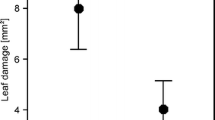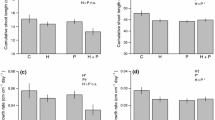Abstract
Terrestrial molluscs and insect herbivores play a major role as plant consumers in a number of ecosystems, but their direct and indirect interactions have hardly been explored. The omnivorous nature of slugs makes them potential disrupters of predator-prey relationships, as a direct threat to small insects and through indirect, plant-mediated effects. Here, we examined the effects of the presence of two species of slugs, Arion rufus (native) and A. vulgaris (invasive) on the survivorship of young Pieris brassicae caterpillars when feeding on Brassica rapa plants, and on plant attractiveness to the main natural enemy of P. brassicae, the parasitoid Cotesia glomerata. In two separate predation experiments, caterpillar mortality was significantly higher on plants co-infested with A. rufus or A. vulgaris. Moreover, caterpillar mortality correlated positively with slug mass and leaf consumption by A. vulgaris. At the third trophic level, plants infested with slugs and plants co-infested with slugs and caterpillars were far less attractive to parasitoids than plants damaged by caterpillars only, independently of slug species. Chemical analyses confirmed that volatile emissions, which provide foraging cues for parasitoids, were strongly reduced in co-infested plants. Our study shows that the presence of slugs has the potential to affect insect populations, directly via consumptive effects, and indirectly via changes in plant volatiles that result in a reduced attraction of natural enemies. The fitness cost for P. brassicae imposed by increased mortality in presence of slugs may be counterbalanced by the benefit of escaping its parasitoids.




Similar content being viewed by others
References
Agrawal AA (2007) Macroevolution of plant defense strategies. Trends Ecol Evol 22:103–109
Ahuja I, Rohloff J, Bones AM (2010) Defence mechanisms of Brassicaceae: implications for plant-insect interactions and potential for integrated pest management. A review. Agron Sustain Dev 30:311–348
Aljanabi SM, Martinez I (1997) Universal and rapid salt-extraction of high quality genomic DNA for PCR-based techniques. Nucl Acids Res 25:4692–4693
Allmann S, Baldwin IT (2010) Insects betray themselves in nature to predators by rapid isomerization of green leaf volatiles. Science 329:1075–1078
Barker GM (2001) The biology of terrestrial molluscs. CABI publishing, Wallingford UK
Barker GM (2002) Molluscs as crop pests. CABI publishing, Wallingford UK
Benrey B, Denno RF (1997) The slow-growth-high-mortality hypothesis: A test using the cabbage butterfly. Ecology 78:987–999
Buschmann H, Keller M, Porret N, Dietz H, Edwards PJ (2005) The effect of slug grazing on vegetation development and plant species diversity in an experimental grassland. Funct Ecol 19:291–298
Chabaane Y, Laplanche D, Turlings TCJ, Desurmont GA (2015) Impact of exotic insect herbivores on native tritrophic interactions: A case study of the African cotton leafworm, Spodoptera littoralis and insects associated with the field mustard Brassica rapa. J Ecol 103:109–117
D’Alessandro M, Turlings TCJ (2005) In situ modification of herbivore-induced plant odors: A novel approach to study the attractiveness of volatile organic compounds to parasitic wasps. Chem Sens 30:739–753
DAISIE (2009) Handbook of alien species in Europe. Springer, Dordrecht
DE Rijk M, Dicke M, Poelman EH (2013) Foraging behaviour by parasitoids in multiherbivore communities. An Behav 85:1517–1528
Desurmont GA, Harvey J, VAN Dam NM, Cristescu SM, Schiestl FP, Cozzolino S, Anderson P, Larsson MC, Kindlmann P, Danner H, Turlings TCJ (2014) Alien interference: disruption of infochemical networks by invasive insect herbivores. Plant Cell Environ 37:1854–1865
Desurmont GA, Laplanche D, Schiestl FP, Turlings TCJ (2015) Floral volatiles interfere with plant attraction of parasitoids: ontogeny-dependent infochemical dynamics in Brassica rapa. BMC Ecol 15:1–11
Falk KL, Kaestner J, Bodenhausen N, Schramm K, Paetz C, Vassao DG, Reichelt M, VON Knorre D, Bergelson J, Erb M, Gershenzon J, Meldau S (2014) The role of glucosinolates and the jasmonic acid pathway in resistance of Arabidopsis thaliana against molluscan herbivores. Mol Ecol 23:1188–1203
Fatouros NE, Lucas-Barbosa D, Weldegergis BT, Pashalidou FG, VAN Loon JJ, Dicke M, Harvey JA, Gols R, Huigens ME (2012) Plant volatiles induced by herbivore egg deposition affect insects of different trophic levels. PLoS one 7:e43607
Fox L, Landis BJ (1973) Notes on the predaceous habits of the gray field slug Deroceras laeve. Environ Entomol 2:306–307
Fritz RS, Hochwender CG, Lewkiewicz DA, Bothwell S, Orians CM (2001) Seedling herbivory by slugs in a willow hybrid system: developmental changes in damage chemical defense and plant performance. Oecologia 129:87–97
Furuichi S (2014) Field observation of predation on paper wasp nests by introduced terrestrial slugs. Insect Soc 61:95–96
Gols R, Harvey JA (2009) Plant-mediated effects in the Brassicaceae on the performance and behaviour of parasitoids. Phytochem Rev 8:187–206
Hall TA (1999) BioEdit: A user-friendly biological sequence alignment editor and analysis program for windows 95/98/NT. Nucl Acids S 41:95–98
Hanley ME, Sykes RJ (2009) Impacts of seedling herbivory on plant competition and implications for species coexistence. Ann Bot-London 103:1347–1353
Hanley ME, Fenner M, Edwards PJ (1995) An experimental field study of the effects of mollusk grazing on seedling recruitment and survival in grassland. J Ecol 83:621–627
Hulme PE (1996) Herbivores and the performance of grassland plants: a comparison of arthropod mollusc and rodent herbivory. J Ecol 84:43–51
Kästner J, VON Knorre D, Himanshu H, Erb M, Baldwin IT, Meldau S (2014) Salicylic acid a plant defense hormone is specifically secreted by a molluscan herbivore. PLoS one 9:e86500
Kosugi Y (2011) Predation of egg masses of oriental tea Tortrix homona magnanima diakonoff and smaller tea Tortrix adoxophyes honmai Yasuda by Valencia slug Lehmannia valentiana (Férussac). Tea Research J 2008:27–34
Kozlowski J (2007) The distribution biology population dynamics and harmfulness of Arion lusitanicus mabille 1868 (gastropoda: pulmonata: arionidae) in Poland. J Plant Protection Res 47:219–230
Kozlowski J (2012) The significance of alien and invasive slug species for plant communities in agrocenoses. J Plant Protection Res 52:67–76
Matsui K (2006) Green leaf volatiles: hydroperoxide lyase pathway of oxylipin metabolism. Curr Opin Plant Biol 9:274–280
Moshgani M, Kolvoort E, DE Jong TJ (2014) Pronounced effects of slug herbivory on seedling recruitment of Brassica cultivars and accessions, especially those with low levels of aliphatic glucosinolates. Basic Appl Ecol 15:607–615
Mumm R, Burow M, Bukovinszkine’Kiss G, Kazantzidou E, Wittstock U, Dicke M, Gershenzon J (2008) Formation of simple nitriles upon glucosinolate hydrolysis affects direct and indirect defense against the specialist herbivore, Pieris rapae. J Chem Ecol 34:1311–1321
Pangesti N, Weldegergis BT, Langendorf B, VAN Loon JJ, Dicke M, Pineda A (2015) Rhizobacterial colonization of roots modulates plant volatile emission and enhances the attraction of a parasitoid wasp to host-infested plants. Oecologia 178:1169–1180
Pianezzola E, Roth S, Hatteland BA (2013) Predation by carabid beetles on the invasive slug Arion vulgaris in an agricultural semi-field experiment. B Entomol Res 103:225–232
Pichersky E, Gershenzon J (2002) The formation and function of plant volatiles: perfumes for pollinator attraction and defense. Curr Opin Plant Biol 5:237–243
Quinteiro J, Rodriguez-Castro J, Castillejo J, Iglesias-Pineiro J, Rey-Mendez M (2005) Phylogeny of slug species of the genus Arion: evidence of of Iberian endemics and of the existence of relict species in Pyrenean refuges. J Zool Syst Evol Res 43:139–148
Rabitsch W (2006) Arion vulgaris (moquin-tandon 1855) fact sheet. Online database of delivering alien invasive species inventories for Europe. http://www.europe-aliens.org/pdf/Arion_vulgaris.pdf.
Sambrook J, Fritsch EF, Maniatis T (1989) Molecular cloning: A laboratory manual. Cold Spring Harbor Laboratory Press, Cold Spring Harbor
Scheidel U, Bruelheide H (2005) Effects of slug herbivory on the seedling establishment of two montane Asteraceae species. Flora 200:309–320
Schroeder FC, Gonzàlez A, Eisner T, Meinwald J (1999) Miriamin, a defensive diterpene from the eggs of a land slug (Arion sp.). Proc Natl Acad Sci U S A 96:13620–13625
Theenhaus A, Scheu S (1996) The influence of slug (Arion rufus) mucus and cast material addition on microbial biomass respiration and nutrient cycling in beech leaf litter. Biol Fert Soils 23:80–85
Ton J, D’Alessandro M, Jourdie V, Jakab G, Karlen D, Held M, Mauch-Mani B, Turlings TCJ (2007) Priming by airborne signals boosts direct and indirect resistance in maize. Plant J 49:16–26
Türke M, Heinze E, Andreas K, Svendsen SM, Gossner MM, Weisser WW (2010) Seed consumption and dispersal of ant-dispersed plants by slugs. Oecologia 163:681–693
Wittstock U, Agerbirk N, Stauber EJ, Olsen CE, Hippler M, Mitchell-Olds T, Gershenzon J, Vogel H (2004) Successful herbivore attack due to metabolic diversion of a plant chemical defense. Proc Natl Acad Sci U S A 101:4859–4864
Acknowledgments
The authors thank Diane Laplanche, Antoine Guiguet, Leslie Mann, and Gabriel Marcacci for their help with rearing the animals used in the study and performing the predation experiments. Xu Hao and Marie-Jeanne Tschudi helped with growing the plants used, and Neil Villard helped with taking pictures and videos of the bioassays. M. A. Z. is grateful to Gerald Heckel for encouraging her to explore different aspects of the A. vulgaris invasion within a PhD project.
Author information
Authors and Affiliations
Corresponding author
Ethics declarations
Conflict of Interest
The authors declare that they have no conflict of interest.
Electronic supplementary material
ESM 1
(DOCX 69 kb)
Rights and permissions
About this article
Cite this article
Desurmont, G.A., Zemanova, M.A. & Turlings, T.C.J. The Gastropod Menace: Slugs on Brassica Plants Affect Caterpillar Survival through Consumption and Interference with Parasitoid Attraction. J Chem Ecol 42, 183–192 (2016). https://doi.org/10.1007/s10886-016-0682-2
Received:
Revised:
Accepted:
Published:
Issue Date:
DOI: https://doi.org/10.1007/s10886-016-0682-2




